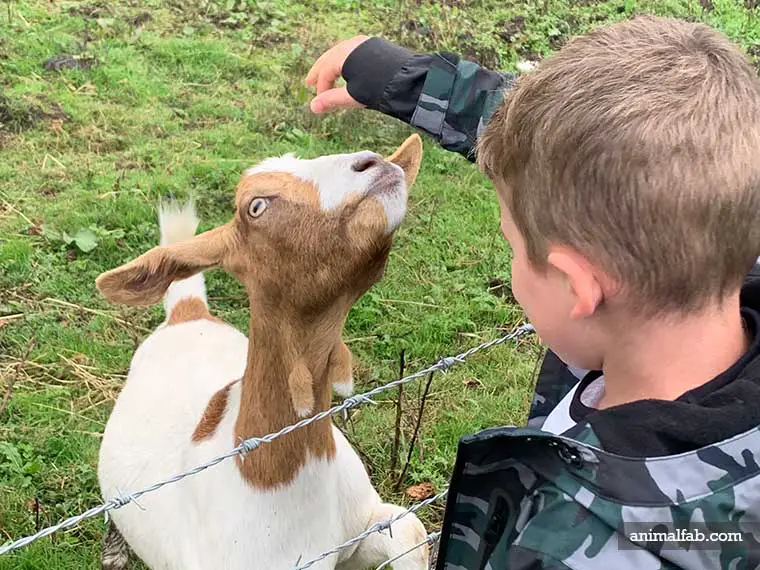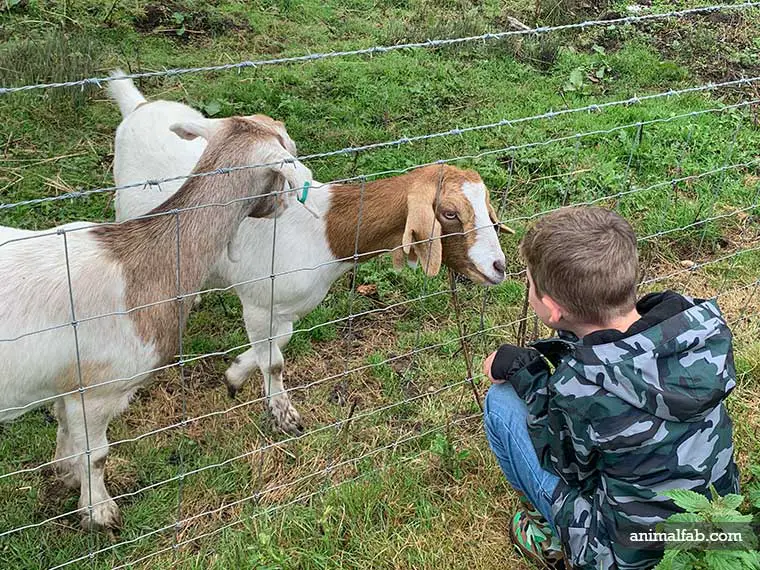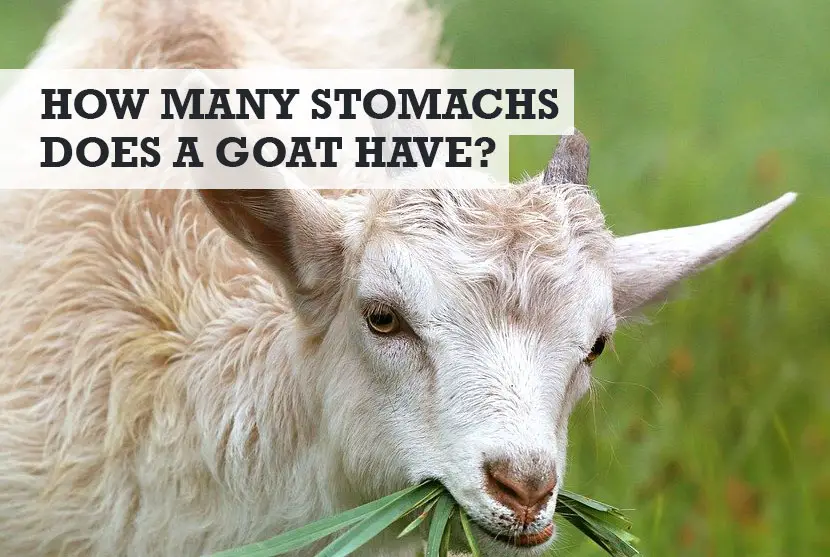You might have heard that goats have more than one stomach, but just how many exactly? In this short guide we asked a vet to explain how many chambers goat’s stomachs have, why they have so many, and which is the largest stomach compartment.
How many stomachs does a goat have? Goats only have 1 stomach, but that stomach has 4 compartments. Despite what you might have heard, this 1 stomach is a large stomach with 4 chambers, and not 4 separate stomachs.
Now that we’ve established that the rumor about goats having 4 stomachs isn’t true, our resident vet would like to explain more about what the 4 compartments are and how it all works.
How many stomachs does a pygmy goat have?
A pygmy goat is a ruminant animal, so large their larger cousins, pygmy goats have just 1 stomach, but within that solitary stomach there are 4 different compartments.
Why does a goat have 4 stomachs?
As established above, goats don’t have 4 stomachs, they have 1. But it’s easy to understand why this is often thought to the case. Here’s the science behind it according to our vet…

Goats are known as ruminant animals. This means they have a digestive tract like sheep, deer, and cows.
Ruminants are efficient at digesting a herbivorous diet, but cannot digest plants directly like other animals. They find plant material particularly challenging to break down.
Here’s how ruminant digestion works in simple terms:
Like other vertebrates, ruminant Artiodactyla (including cattle, deer, and their relatives) are unable to digest plant material directly, because they lack enzymes to break down cellulose in the cell walls. Digestion in ruminants occurs sequentially in a four-chambered stomach.
Memorial University, https://www.mun.ca/biology/scarr/Ruminant_Digestion.html
What are the 4 stomachs of a goat?
Hopefully we clear now, but goats don’t have 4 stomachs, they only have one stomach, but that large stomach has four chambers to it. While each chamber has a different digestive function, they are all sections of one large stomach, and not four separate stomachs.
So, the question here instead should really be, what are the 4 stomach “compartments” of a goat. Scroll down a little and you can find out.
What are the 4 stomach compartments of a goat? The 4 compartments and chambers of a goat’s stomach are the reticulum, rumen, omasum, and abomasum.
How many compartments does a goat’s stomach have?
Goats have 4 compartments in their stomach. The multiple chambers are vital because plant materials don’t undergo acidic breakdown alone efficiently. Therefore, mechanical and microbial digestion in the earlier chambers of the stomach aid in the breakdown of food for goats before reaching the stomach acid.
The passage of food through the four chambers begins in the reticulum, before moving to the rumen, then the omasum and finally the abomasum. Below our vet has reviewed the different sections of a goat’s stomach and their different functions.
1. Reticulum
The food and forage first enter the reticulum from the esophagus. The inner surface of the reticulum has honeycomb shaped projections which aid in sorting the sizes for the food particles.
The larger particles can be regurgitated and rechewed to break down further or be sent into the next chamber stomach.
Very small particles can bypass the rumen altogether and go straight to the omasum. This is particularly common in very young kids who are still drinking milk.
The reticulum is only separated from the rumen by the rumino-reticular fold, and therefore even though it can hold up to 0.5 gallons in a large goat, it doesn’t have the capacity to hold onto food.
In addition to this, since it is only separated by a fold, the microbes from the rumen are also present within the reticulum.
Because of the reticulum’s position at the bottom of the esophagus, this is the most common place for foreign objects to become stuck, such as nails and wire.
Handy Hint: Banding a goat is a common practise, but did you know there’s a right age bracket when the banding should be done?
2. Rumen
The capacity of the rumen is usually between three and six gallons depending on what food the goat has recently eaten, and it is lined with tiny fingerlike projections known as papillae. The movements of the rumen make it the noisy part of stomach, but also aid in mechanical breakdown of the food.
Which compartment of the goat stomach is the largest? The rumen is the largest of the goat stomach compartments. It can hold 3 to 6 gallons and plays an important part in digestion.
It is the largest stomach chamber of an adult goat and is full of microbes. These microbes play an important role of breaking down otherwise indigestible plant material, known as cellulose, into the volatile fatty acids, acetic, butyric, and propionic acids.

The volatile fatty acids can be absorbed through the rumen wall and are the main contributor to the goat’s energy needs. The rumen can also convert feed components into vitamin Bs, vitamin K and amino acids.
As a by-product of digestion, the microbes produce gas as they digest plant material. Therefore, goats (and other ruminants) must periodically burp to prevent bloating of the stomach.
This is known as eructation.
Handy Hint: Have you heard the rumor about cows having 4 hearts? Here’s the truth about the number of hearts a cow has.
3. Omasum
The third chamber of a goat’s stomach is the omasum, which is very small, only holding up to 0.25 gallons. The lining consists of many leaf-like folds which further break down food, as well as further absorb volatile fatty acids and some of the water content.
4. Abomasum
The final goat stomach compartment is the abomasum, which is the most similar chamber to a monogastric stomach. It is approximately one gallon in size.
The abomasum is lined with parietal cells, which secrete stomach acid, as well as chief cells, which secrete the enzyme pepsin.
Pepsin is responsible for breaking down proteins before they enter the small intestine, and the stomach acid further breaks down food particles ready for enzymatic digestion in the intestines.
Handy Hint: I recently explored the challenges with herding goats versus sheep. You might find it quite surprising the differences!
Conclusion
Goats are ruminants which have one, four-chambered stomach. The multichambered structure of the stomach enables several different ways the food can be broken down and digested.
By having 4 compartments in their stomach, is ensures that food material which is challenging to digest can be broken down effectively, using microbes, stomach acid, mechanical movements, and the functions of the different stomach linings.
You might also like…
- Will a goat and a cat get along and be able to live together?
- Can Donkeys and Horses Mate Naturally or in the Wild?
- You can run, but you can’t hide from jumping crocodiles
Image in header via https://pixabay.com/photos/goat-grass-livestock-grazing-1596880/

